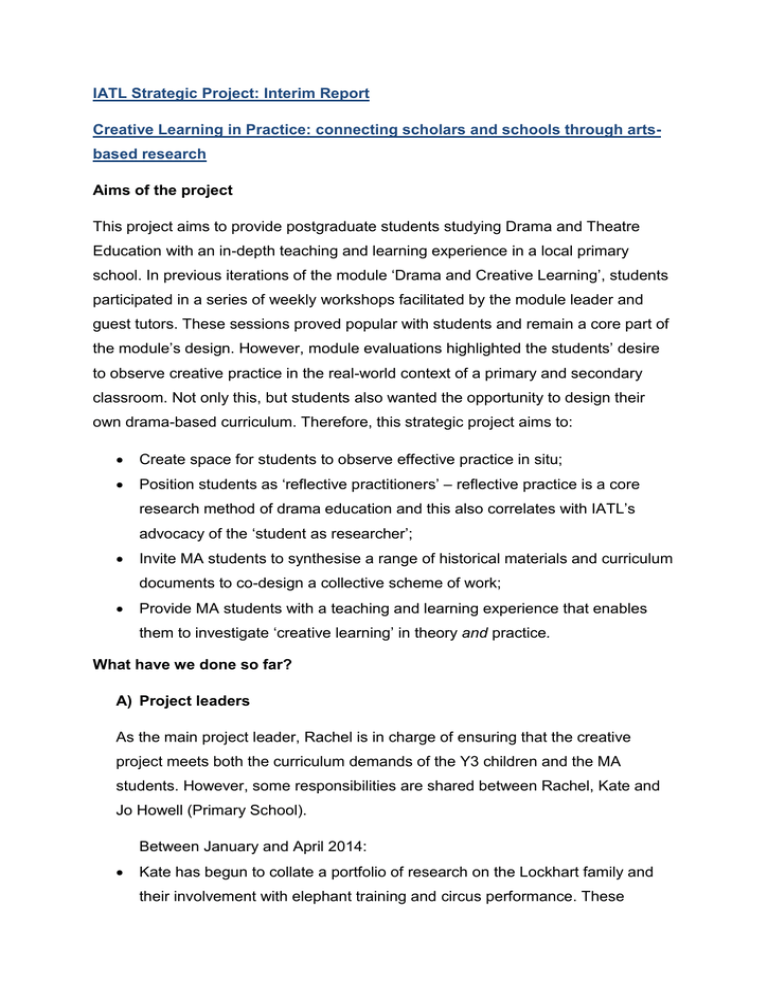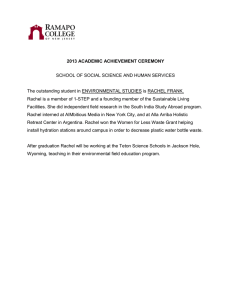IATL Strategic Project: Interim Report
advertisement

IATL Strategic Project: Interim Report Creative Learning in Practice: connecting scholars and schools through artsbased research Aims of the project This project aims to provide postgraduate students studying Drama and Theatre Education with an in-depth teaching and learning experience in a local primary school. In previous iterations of the module ‘Drama and Creative Learning’, students participated in a series of weekly workshops facilitated by the module leader and guest tutors. These sessions proved popular with students and remain a core part of the module’s design. However, module evaluations highlighted the students’ desire to observe creative practice in the real-world context of a primary and secondary classroom. Not only this, but students also wanted the opportunity to design their own drama-based curriculum. Therefore, this strategic project aims to: Create space for students to observe effective practice in situ; Position students as ‘reflective practitioners’ – reflective practice is a core research method of drama education and this also correlates with IATL’s advocacy of the ‘student as researcher’; Invite MA students to synthesise a range of historical materials and curriculum documents to co-design a collective scheme of work; Provide MA students with a teaching and learning experience that enables them to investigate ‘creative learning’ in theory and practice. What have we done so far? A) Project leaders As the main project leader, Rachel is in charge of ensuring that the creative project meets both the curriculum demands of the Y3 children and the MA students. However, some responsibilities are shared between Rachel, Kate and Jo Howell (Primary School). Between January and April 2014: Kate has begun to collate a portfolio of research on the Lockhart family and their involvement with elephant training and circus performance. These materials will be used as stimuli for the MA students in June 2014 who will then be supported to produce their own learning resources for the Y3 children. Rachel is researching the theoretical background of the slippery term ‘creative learning’. Alongside this, she is also reviewing other cognate practices to understand if this project offers an alternative paradigm. Rachel, Kate and Jo Howell have met to coordinate shared curriculum aims and objectives for Y3 and MAs. During this planning phase, key questions have emerged about the nature of Higher Education teaching and learning. In what ways do the curriculum, pedagogy and assessment of a postgraduate module and Key stage 2 primary interrelate? What are the overlaps and lacunae? Most significantly, ‘interdisciplinarity’ has emerged as a key area of interest. Rachel has attended two sessions on IATL’s interdisciplinary module on ‘Human-Animal Studies’. As detailed below, not only has the content of these lectures provided a new direction for the project but it has also highlighted the potential of knowledge exchange when working cross-institutionally (i.e. HE and Primary school). B) Y3 children and MA Students On 25th Feb 2014, MA students visited the partnership primary school. For the morning session, students were introduced to the theme of the ‘circus’ by being presented with a range of vintage circus posters. Jo led a series of drama-based exercises with the MA students. In particular, attention was drawn to the relationships between animals and humans. During this limited time, MA students then worked with groups of Y3 students to produce a series of short performances. The children were invited to physicalize various circus animals. In the afternoon session, MA and Y3 children were inspired by a clip from Charlie Chaplin’s The Circus to produce their own short, silent movies. They explored the ways they can create tension and suspense through the body. MA students were given 'reflective journals' to begin logging their experiences throughout the day. They were also invited to ask Jo questions about her practice. Key emerging ideas - Interdisciplinary teaching and learning Even though only in its initial stages, this collaborative project has highlighted the intrinsic value of interdisciplinary teaching and learning methods. The simulation of history and drama and theatre education has generated a stimulating environment for both students and the school children. Significantly, the MA students are being gradually presented with historical material for them to transform into educational materials. It is hoped that this careful ‘scaffolding’ will lead to an empowerment of the students-as-educators. Given that Kate is unfamiliar with drama pedagogy and Rachel is unfamiliar with archival research of this nature, both project leaders are finding that their collaborative discussions are generating new ways of thinking about teaching and learning. As an ancient historian and educator, Kate is accustomed to synthesising information into lectures and seminars. This is based upon the principle that the educational experience results from the information presented in the classroom. This project has challenged this principle and furthermore, her approach to producing educational materials. By presenting this historical material to Rachel, Kate is learning an entirely new creative format to educate. Incorporating performance methodologies into her teaching and learning practice will be one of the lasting effects of this project. Likewise, Rachel is learning how historical knowledge can be curated for educational purposes. Jo Howell’s expertise as a specialist arts teacher is also shaping this shared creative process. Another significant development has been the influence of the IATL interdisciplinary module on Human-Animals Studies. Rachel audited seminars on ‘human-animal kinship’ and ‘animals as spectacle and entertainment’ which raised questions about the history of animal training and animal cruelty and welfare. This is relevant to our investigations into Lockhart’s relationship with his three elephants. Some lines of inquiry to explore are; ‘Why is this elephant circus part of Leamington’s history rather than a continuing form of entertainment?’ ‘By remembering the circus, are we celebrating Lockhart’s success as an elephant trainer or are we recognising the maltreatment of exotic elephants in the Victorian circus?’ We are keen for these questions to inform the subsequent sessions. We are organising a site visit to The Elephant House in Leamington Spa where the MA students will create interactive activities for the Y3 children. - ‘Practice-as-policy’ Whilst the project aims to explore ‘creative learning’ in school contexts, it is also providing an opportunity for Rachel and Kate to consider what ‘creative learning’ might mean in within a HE context. By designing and facilitating this interdisciplinary project, they are developing their practice as a HE Teaching Fellows. Like the MA students, Rachel is working as a ‘reflective-practitioner’ and she is using this project to reflect on the principles that guide her pedagogical approaches. She is also able to use this practical project to consider the broader challenges and opportunities of HE teaching and learning.1 For example, Rachel has recently joined the ‘practice-aspolicy’ Teaching Fellow group led by Jonny Heron and she hopes that this project will prove relevant to the interests of this group. As a member of Warwick’s Public Engagement network, Rachel is keen to explore the ways academic programmes can benefit from working with local schools and community groups and vice versa. Challenges In the original application, we stated that the learning resources created by the MA students would result in a booklet or DVD. We have since decided that a website would be better suited to our needs as it would allow the project leaders to keep updating new materials as the project progresses. However, none of the group members have any expertise in web design and nor is there money allocated for this in the budget. We have sought help from the CES but we are restricted by Warwick’s site-builder format. We continue to look for appropriate resource for this and Prezi and Blendspace may well prove useful. 1 Rachel is aiming to use this IATL project as part of her ‘negotiated project’ for PCAPP.

